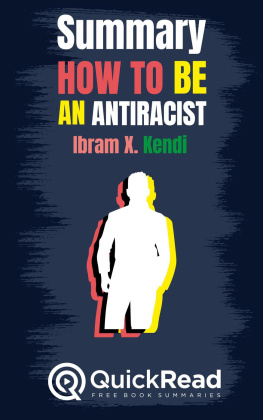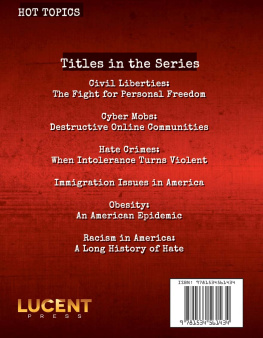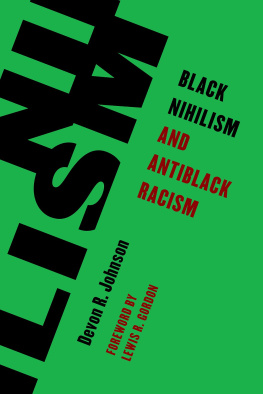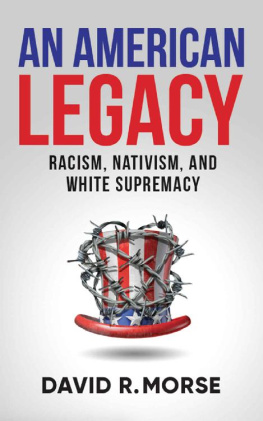Thank you for buying this ebook, published by NYU Press.
Sign up for our e-newsletters to receive information about forthcoming books, special discounts, and more!
Sign Up!
About NYU Press
A publisher of original scholarship since its founding in 1916, New York University Press Produces more than 100 new books each year, with a backlist of 3,000 titles in print. Working across the humanities and social sciences, NYU Press has award-winning lists in sociology, law, cultural and American studies, religion, American history, anthropology, politics, criminology, media and communication, literary studies, and psychology.
Negrophobia and Reasonable Racism
Critical America
General Editors: RICHARD DELGADO and JEAN STEFANCIC
White by Law: The Legal Construction of Race
Ian F. Haney Lpez
Cultivating Intelligence: Power, Law, and the Politics of Teaching
Louise Harmon and Deborah W. Post
Privilege Revealed: How Invisible Preference Undermines America
Stephanie M. Wildman with Margalynne Armstrong, Adrienne D. Davis, and Trina Grillo
Does the Law Morally Bind the Poor? or What Goods the Constitution When You Cant Afford a Loaf of Bread
R. George Wright
Hybrid: Bisexuals, Multiracials, and Other Misfits under American Law
Ruth Colker
Critical Race Feminism: A Reader
Edited by Adrien Katherine Wing
Immigrants Out! The New Nativism and the Anti-Immigrant Impulse in the United States
Edited by Juan F. Perea
Taxing America
Edited by Karen B. Brown and Mary Louise Fellows
Notes of a Racial Caste Baby: Colorblindness and the End of Affirmative Action
Bryan K. Fair
Please Dont Wish Me a Merry Christmas:
A Critical History of the Separation of Church and State
Stephen M. Feldman
To Be an American: Cultural Pluralism and the Rhetoric of Assimilation
Bill Ong Hing
Negrophobia and Reasonable Racism: The Hidden Costs of Being Black in America
Jody David Armour
Black Rage Confronts the Law
Paul Harris
NEGROPHOBIA AND REASONABLE RACISM
The Hidden Costs of Being Black in America
Jody David Armour

NEW YORK UNIVERSITY PRESS
New York and London
Copyright 1997 by New York University
All rights reserved
Library of Congress Cataloging-in-Publication Data
Armour, Jody David.
Negrophobia and reasonable racism : the hidden costs of being
Black in America / Jody David Armour.
p. cm. (Critical America)
Includes bibliographical references (p. ) and index.
ISBN 0-8147-0640-1 (acid-free paper)
1. Discrimination in criminal justice administrationUnited States.
2. Afro-AmericansCivil rights. 3. RacismUnited States.
4. United StatesRace relations. I. Title. II. Series.
HV9950.A75 1997
305.896073dc21 96-51306
CIP
New York University Press books are printed on acid-free paper,
and their binding materials are chosen for strength and durability.
Manufactured in the United States of America
10 9 8 7 6 5 4 3 2 1
To Addie Armour and in memory of Fred Armour
CONTENTS
Introduction
Rational Discrimination and the Black Tax
Chapter One
The Reasonable Racist: A Slippery Oxymoron
Chapter Two
The Intelligent Bayesian:
Reckoning with Rational Discrimination
Chapter Three
The Involuntary Negrophobe
Chapter Four
Of Mice and Men: Equal Protection and Unconscious Bias
Chapter Five
Blame and Punishment: Narrative, Perspective, Scapegoats, and Demons
Chapter Six
Repealing the Black Tax: Breaking the Discrimination Habit
ACKNOWLEDGMENTS
I presented portions of this book at various workshops, colloquia, and faculty seminars in Colorado, Indiana, Pittsburgh, and at the University of Southern California. I gained much from these workshops, seminars, and colloquia, and thank all those who participated. Parts of the book were also presented at the American Association on Law Schools Conference on Torts and at another AALS Conference on Evidence. I received valuable comments from participants at both conferences.
Outside these organized forums, Phreda Devereaux provided extremely helpful remarks on the chapter on Negrophobia; Frank McClelland offered penetrating comments on the chapter on stereotypes and prejudice; and Martha Chamallas, Jules Lobel, Rhonda Wasserman, and Welsh White read large portions of the manuscript, making many very thoughtful remarks. The discussions of battered women benefited greatly from suggestions by Veronica Hobbs of Advocates for Basic Legal Equality. I am also indebted to Martine Beauman, Rhonda Evans, Dominck Lee, Piyush Seth, and Christopher White for valuable research assistance, and to LuAnn Driscoll, Karen Knochel, Darleen Mocello, Carolyn Rohan, and Barbara Salopek for patient, precise, tireless document processing assistance.
I am also grateful to my editors, Richard Delgado, Niko Pfund, and Jean Stefancic, and to New York University Press. And I am thankful to the following journals for permission to use portions of essays that first appeared in their pages: Stanford Law Review, Race Ipsa Loquitur: Of Reasonable Racists, Intelligent Bayesians, and Involuntary Negrophobes [46 Stan. L. Rev. 781 (1994)]; California Law Review, Stereotypes and Prejudice: Helping Legal Decisionmakers Break the Prejudice Habit [83 Cal. L. Rev. 733 (1995)].
Negrophobia and Reasonable Racism
Introduction
RATIONAL DISCRIMINATION AND THE BLACK TAX
It is a rainy night in a combined residential and commercial neighborhood in a predominantly White upper-middle-class section of a major U.S. city. It is 10:30 P.M. It is raining hard. Although most of the fashionable shops and boutiques in the neighborhood have closed, the neighborhood bank contains an automatic teller. The machine is located in a lobby between two sets of glass doors, the first of which opens directly into the bank and is locked at closing each day, while the second leads to the public sidewalk and remains open twenty-four hours.
A middle-aged resident of the neighborhood enters the banks lobby, inserts her bank card into the machine, and requests two hundred dollars. As she waits for her transaction to be processed, the woman suddenly notices a figure moving directly toward the lobby from across the street. Focusing herfull attention on the approaching figure, she notes that the person is a young man (at most twenty-something); that he is wearing a trench coat with an upturned collar and a tarpaulin hat pulled down even with his eyes (perhaps in deference to the pouring rain); and that he is Black.
The trench-coat-clad young man glances down the deserted street as he reaches the lobby and then enters, pushing his right shoulder against one of the swinging glass doors. As he pushes the door open, he unbuttons the collar of his trench coat with his right hand and reaches into the coat in the direction of his left armpit. With his eyes focused on the space beneath his coat into which he is reaching, he takes hold of something and begins to withdraw it.
Panic-stricken and conscious of the rhythmic clicking of the automatic teller churning out ten fresh twenty-dollar bills, the woman pulls a small .22 calibre pistol from her purse and levels it at the entering figure. As the young man looks up from his coat, he sees the pistol trained on him and reflexively thrusts his right handwhich now contains a billfold retrieved from his inside breast pocketout in front of him, shouting at the woman not to shoot. Perceiving a handgun thrust in her direction and startled by the mans unintelligible shouts, the woman shoots the Black man, who dies clutching his bank card
Next page








